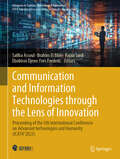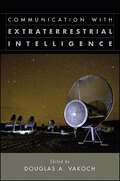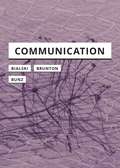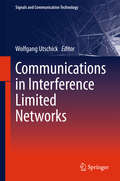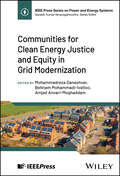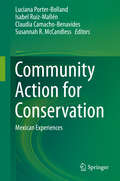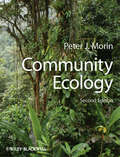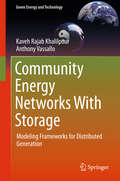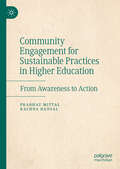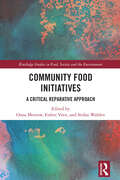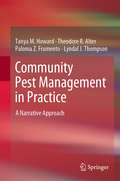- Table View
- List View
Communication and Engagement with Science and Technology: Issues and Dilemmas - A Reader in Science Communication
by John K. Gilbert Susan StocklmayerScience communication seeks to engage individuals and groups with evidence-based information about the nature, outcomes, and social consequences of science and technology. This text provides an overview of this burgeoning field ─ the issues with which it deals, important influences that affect it, the challenges that it faces. It introduces readers to the research-based literature about science communication and shows how it relates to actual or potential practice. A "Further Exploration" section provides suggestions for activities that readers might do to explore the issues raised. Organized around five themes, each chapter addresses a different aspect of science communication: • Models of science communication – theory into practice • Challenges in communicating science • Major themes in science communication • Informal learning • Communication of contemporary issues in science and society Relevant for all those interested in and concerned about current issues and developments in science communication, this volume is an ideal text for courses and a must-have resource for faculty, students, and professionals in this field.
Communication and Information Technologies through the Lens of Innovation: Proceeding of the 5th International Conference on Advanced technologies and Humanity (ICATH'2023) (Advances in Science, Technology & Innovation)
by Rajaa Saidi Brahim El Bhiri Saliha Assoul Ebobisse Djene Yves FredericThis book is a comprehensive proceedings book that delves into cutting-edge research and insights in the field of communication and information technologies. Featuring a wide range of research papers and case studies, this book offers a deep exploration of the intersection between technology, innovation, and communication. From examining the impact of digital transformation on organizational change to investigating the role of smart education and intelligent learning systems, each chapter provides valuable insights into key topics shaping the landscape of communication and information technologies. The book offers case studies that highlight the implementation of digital platforms for legal information and the leveraging of e-services for enhanced importation and foreign investments. This book also delves into advancements in machine learning, including studies on imbalanced datasets and disease categorization. It explores the realm of edge computing systems with a focus on workflow scheduling and examines the impact of radiofrequency on biological systems. Readers will gain valuable insights into antenna design for various applications, satellite imagery analysis, virtual reality therapy for autism, and the simulation of dento-facial deformities through 3D virtual model simulation. With a focus on practical research and innovative solutions, this book serves as a valuable resource for researchers, practitioners, and industry professionals interested in the evolving landscape of technology-driven communication and information systems.
Communication and Popularization of Science and Technology in China
by Fujun Ren Jiequan ZhaiThis book aims to be a reference for researchers studying the promotion of scientific literacy in China, as well as a guide for those interested in promoting scientific awareness. It covers advances in science and technology, communication and popularization practice, and research (STCP) both in China and abroad. Theoretical issues are discussed, and important problems in promoting scientific and technological awareness are identified (e. g. : basic principles, structures, channels of communication and current needs) This bookprovides a summary of the advances in STCP in China in recent years (especially after the issuing of the "National Scientific Literacy Outline") including STCP resource and capacity building, science popularization policies, practitioner development, infrastructure construction, and the development of the science popularization industry as a whole. At the same time, this book also reviews thedesign, organization, monitoring and evaluation of science and technology communication and popularization programs. It also highlights current STCP trends and developments in China and calls for a greater emphasis to be placed on research into promoting scientific literacy. It is hoped that this book will be useful to readers both in China and abroad by familiarizing them with the history and theory of STCP as well as its development over time. The 1st chapter briefly reviews the history of STCP. The 2nd through 5th chapters discuss the conceptual framework, basic structure, methods of communication, and current STCP needs. The 6th chapter introduces the principle content of programs aimed at improving Chinese citizens' scientific literacy, while the 7th and 8th chapters analyze the resources, capacities and conditions that have been developed for STCP in China. The 9th chapter investigates the organization, monitoring and evaluation of science popularization practices, and the final chapter summarizes important STCP topics and trends in contemporary China.
Communication in Atypical Infants and Toddlers
by Christina F. PapaeliouThis book presents a comparative review of the latest studies and data on prelinguistic communication and early semantic development in autism spectrum disorder (ASD), Williams syndrome (WMS), attention-deficit/hyperactivity disorder (ADHD), and early language delay. Papaeliou offers a critical analysis of the literature, compares key theoretical approaches, and interprets data on development in atypical populations.A fruitful synthesis of theory and research reveals that, instead of cognitive deficits, the core feature of these neurodevelopmental disorders consists of deficits in the ability for self- and intersubjective coordination, which adversely affects early interactions and, consequently, the emergence of language. The book composes fragmentary proposals on the role of rhythm disruptions in different conditions, setting out the idea that disruption in interactional synchrony is a connecting thread through neurodevelopmental disorders which show high prevalence or high comorbidity rates. Papaeliou identifies distinct communicative patterns characteristic of each disorder and puts forward a unifying theory for interpreting data on early communication and language development in atypical populations.This is ideal reading for psychologists, psycholinguists, psychiatrists, paediatricians, speech therapists, and special educators. Students in developmental psychology and anyone interested in understanding the research behind typical and atypical development will also benefit from this text.
Communication with Extraterrestrial Intelligence (CETI)
by Douglas A. VakochIn April 2010, fifty years to the month after the first experiment in the Search for Extraterrestrial Intelligence (SETI), scholars from a range of disciplines—including astronomy, mathematics, anthropology, history, and cognitive science—gathered at NASA's biennial Astrobiology Science Conference (AbSciCon) for a series of sessions on the search for intelligent life. This book highlights the most recent developments in SETI discussed at that conference, emphasizing the ways that SETI has grown since its inception. The volume covers three broad themes: First, leading researchers examine the latest developments in observational SETI programs, as well as innovative proposals for new search strategies and novel approaches to signal processing. Second, both proponents and opponents of "Active SETI" debate whether humankind should be transmitting intentional signals to other possible civilizations, rather than only listening. Third, constructive proposals for interstellar messages are juxtaposed with critiques that ask whether any meaningful exchange is possible with an independently evolved civilization, given the constraints of contact at interstellar distances, where a round-trip exchange could take centuries or millennia.As we reflect on a half-century of SETI research, we are reminded of the expansion of search programs made possible by technological and conceptual advances. In this spirit of ongoing exploration, the contributors to this book advocate a diverse range of approaches to make SETI increasingly more powerful and effective, as we embark on the next half-century of searching for intelligence beyond Earth.
Communication, Culture and Ecology: Rethinking Sustainable Development in Asia (Communication, Culture and Change in Asia #6)
by Kiran PrasadThis book offers comprehensive insights into the cultural and ecological values that influence sustainable development across Asia, addressing the cultural, religious and philosophical moorings of development through participatory and grassroots communication approaches. It presents a range of contributions and case studies from leading experts in Asia to highlight the debates on environmental communication and sustainable development that are relevant today, and to provide an overview of the positive traditions of ecological sensitivity and cultural communication that may find common ground between communities. This well-researched guide to the dynamic and complex terrain of communication for sustainable development offers uniquely practical perspectives on communication, environment and sustainable development that are of immense value for policy makers, media scholars, development practitioners, researchers and students of communication and media studies.
Communication-Protocol-Based Filtering and Control of Networked Systems (Studies in Systems, Decision and Control #430)
by Zidong Wang Lei Zou Jinling LiangCommunication-Protocol-Based Filtering and Control of Networked Systems is a self-contained treatment of the state of the art in communication-protocol-based filtering and control; recent advances in networked systems; and the potential for application in sensor networks. This book provides new concepts, new models and new methodologies with practical significance in control engineering and signal processing. The book first establishes signal-transmission models subject to different communication protocols and then develops new filter design techniques based on those models and preset requirements for filtering performance. The authors then extend this work to finite-horizon H-infinity control, ultimately bounded control and finite-horizon consensus control. The focus throughout is on three typical communications protocols: the round-robin, random-access and try-once-and-discard protocols, and the systems studied are drawn from a variety of classes, among them nonlinear systems, time-delayed and time-varying systems, multi-agent systems and complex networks. Readers are shown the latest techniques—recursive linear matrix inequalities, backward recursive difference equations, stochastic analysis and mapping methods. The unified framework for communication-protocol-based filtering and control for different networked systems established in the book will be of interest to academic researchers and practicing engineers working with communications and other signal-processing systems. Senior undergraduate and graduate students looking to increase their knowledge of current methods in control and signal processing of networked systems will also find this book valuable.
Communication: Essays On Communication, Materiality, And Society (In Search of Media)
by Mercedes Bunz Paula Bialski Finn BruntonOn contemporary communication in its various human and nonhuman formsContemporary communication puts us not only in conversation with one another but also with our machinery. Machine communication—to communicate not just via but also with machines—is therefore the focus of this volume. Diving into digital communications history, Finn Brunton brings to the fore the alienness of computational communication by looking at network timekeeping, automated trolling, and early attempts at communication with extraterrestrial life. Picking up this fascination with inhuman communication, Mercedes Bunz then performs a close reading of interaction design and interfaces to show how technology addresses humans (as very young children). Finally, Paula Bialski shares her findings from a field study of software development, analyzing the communicative forms that occur when code is written by separate people. Today, communication unfolds merely between two or more conscious entities but often includes an invisible third party. Inspired by this drastic shift, this volume uncovers new meanings of what it means &“to communicate.&”
Communications in Interference Limited Networks (Signals and Communication Technology)
by Wolfgang UtschickThis book offers means to handle interference as a central problem of operating wireless networks. It investigates centralized and decentralized methods to avoid and handle interference as well as approaches that resolve interference constructively. The latter type of approach tries to solve the joint detection and estimation problem of several data streams that share a common medium. In fact, an exciting insight into the operation of networks is that it may be beneficial, in terms of an overall throughput, to actively create and manage interference. Thus, when handled properly, "mixing" of data in networks becomes a useful tool of operation rather than the nuisance as which it has been treated traditionally. With the development of mobile, robust, ubiquitous, reliable and instantaneous communication being a driving and enabling factor of an information centric economy, the understanding, mitigation and exploitation of interference in networks must be seen as a centrally important task.
Communities for Clean Energy Justice and Equity in Grid Modernization (IEEE Press Series on Power and Energy Systems)
by Behnam Mohammadi-Ivatloo Mohammadreza Daneshvar Amjad Anvari-MoghaddamComprehensive blueprint to understand, develop, and implement clean energy initiatives and achieve energy justice and equity worldwide Communities for Clean Energy Justice and Equity in Grid Modernization presents fundamental theories, technologies, and solutions for real-world problems in the operation and planning of clean, safe, resilient, and efficient energy communities that deliver energy justice and equity. The initial chapters of the book focus on conceptual requirements, emphasizing the definition, structure, features, and challenges of promoting energy justice and equity through the coordinated operation of clean energy communities. Subsequent chapters explore potential technologies and systems to achieve these objectives, examining functionalities in modern energy grids, including self-healing systems, sustainable energy networks, and intelligent, multidimensional communities of agents. Edited by a team of highly qualified experts, the book explores additional topics including: Decision-making tools for optimized operation and planning of multi-energy communitiesHolistic energy availability frameworks capable of dealing with changes and interactions in modern energy gridsThe role of artificial intelligence, machine learning, citizenship, and democracy in realizing energy justice and equityHybrid transitional energy markets, energy policy strategies, and business models related to localization of energy technologies Energy storage and trading solutions, hybrid energy technologies, and grid-edge solutions Communities for Clean Energy Justice and Equity in Grid Modernization is an essential reference on the subject for electrical, mechanical, civil, architectural, and environmental engineers, along with professionals working in power and energy utility companies and policy makers seeking a holistic understanding of the subject.
Communities of Learned Experience: Epistolary Medicine in the Renaissance (Singleton Center Books in Premodern Europe)
by Nancy G. SiraisiSixteenth-century physicians had their letters on medical topics published in printed collections to record their exchange of ideas and make known their professional expertise.During the Renaissance, collections of letters both satisfied humanist enthusiasm for ancient literary forms and provided the flexibility of a format appropriate to many types of inquiry. The printed collections of medical letters by Giovanni Manardo of Ferrara and other physicians in early sixteenth-century Europe may thus be regarded as products of medical humanism. The letters of mid- and late sixteenth-century Italian and German physicians examined in Communities of Learned Experience by Nancy G. Siraisi also illustrate practices associated with the concepts of the Republic of Letters: open and relatively informal communication among a learned community and a liberal exchange of information and ideas. Additionally, such published medical correspondence may often have served to provide mutual reinforcement of professional reputation. Siraisi uses some of these collections to compare approaches to sharing medical knowledge across broad regions of Europe and within a city, with the goal of illuminating geographic differences as well as diversity within social, urban, courtly, and academic environments. The collections she has selected include essays on general medical topics addressed to colleagues or disciples, some advice for individual patients (usually written at the request of the patient’s doctor), and a strong dose of controversy.
Community Action for Conservation: Mexican Experiences
by Luciana Porter-Bolland Isabel Ruiz-Mallén Claudia Camacho-Benavides Susannah R. MccandlessThis book provides an in-depth analysis on community conservation in Mexico. The volume explores vivid examples and case studies that illustrate some of the critical issues at stake, including the participation of local communities in national and global conservation, indigenous and local perceptions of conservation initiatives in Southern Mexico, and challenges in ICCA governance and ecotourism. The book also reviews methodological approaches for understanding and strengthening community conservation, touching upon such topics as community-based biodiversity monitoring and tools for understanding children's perceptions of community conservation. Written by international experts in the field, Community Action for Conservation: Mexican Experiences is a lively and deep-running resource that offers invaluable stories and analyses of the Mexican experience with conservation.
Community Adaptation and Vulnerability in Arctic Regions: Framework Document For An International Polar Year Consortium
by Barry Smit Grete K. HovelsrudUnder the auspices of International Polar Year (IPY), the CAVIAR consortium was formed with partners from all eight Arctic countries. The aim of the interdisciplinary CAVIAR project is to increase understanding of the vulnerability of Arctic communities to changing environmental conditions, including climate change, and to contribute to the development of adaptive strategies and policies. In partnership with local collaborators in over two dozen communities, researchers have documented the conditions and forces that contribute to vulnerabilities, identified adaptive strategies and attempted to assess the prospects for adaptation in the future.
Community Based System Dynamics
by Peter S. HovmandCommunity Based System Dynamics introduces researchers and practitioners to the design and application of participatory systems modeling with diverse communities. The book bridges community- based participatory research methods and rigorous computational modeling approaches to understanding communities as complex systems. It emphasizes the importance of community involvement both to understand the underlying system and to aid in implementation. Comprehensive in its scope, the volume includes topics that span the entire process of participatory systems modeling, from the initial engagement and conceptualization of community issues to model building, analysis, and project evaluation. Community Based System Dynamics is a highly valuable resource for anyone interested in helping to advance social justice using system dynamics, community involvement, and group model building, and helping to make communities a better place.
Community Disaster Recovery and Resiliency: Exploring Global Opportunities and Challenges
by Jason David Rivera DeMond Shondell MillerOnce again nature‘s fury has taken a toll in pain, suffering, and lives lost. In recognition of the need for a rapid and appropriate response, CRC Press will donate $5 to the American Red Cross for every copy of Community Disaster Recovery and Resiliency: Exploring Global Opportunities and Challenges sold. In the past, societies would learn from di
Community Ecology: Processes, Models, And Applications (Coursesmart Ser.)
by Peter J. MorinAll life on earth occurs in natural assemblages called communities. Community ecology is the study of patterns and processes involving these collections of two or more species. Communities are typically studied using a diversity of techniques, including observations of natural history, statistical descriptions of natural patterns, laboratory and field experiments, and mathematical modelling. Community patterns arise from a complex assortment of processes including competition, predation, mutualism, indirect effects, habitat selection, which result in the most complex biological entities on earth – including iconic systems such as rain forests and coral reefs. This book introduces the reader to a balanced coverage of concepts and theories central to community ecology, using examples drawn from terrestrial, freshwater, and marine systems, and focusing on animal, plant, and microbial species. The historical development of key concepts is described using descriptions of classic studies, while examples of exciting new developments in recent studies are used to point toward future advances in our understanding of community organization. Throughout, there is an emphasis on the crucial interplay between observations, experiments, and mathematical models. This second updated edition is a valuable resource for advanced undergraduates, graduate students, and established scientists who seek a broad overview of community ecology. The book has developed from a course in community ecology that has been taught by the author since 1983. Figures and tables can be downloaded for free from www.wiley.com/go/morin/communityecology
Community Energy Networks With Storage: Modeling Frameworks for Distributed Generation (Green Energy and Technology)
by Kaveh Rajab Khalilpour Anthony VassalloThis book addresses the problem of building an optimal community energy network in a decentralized distributed energy context. The book introduces a few novel modeling frameworks to assist a single customer or a community of multiple end-user customers in building their optimal electricity system/network and operating their own local energy system. The content of the book is suitable for students, academics and industrial practitioners studying or working in the area of energy management and smart grid energy networks.
Community Energy and Sustainable Energy Transitions: Experiences from Ethiopia, Malawi and Mozambique
by Vanesa Castán BrotoThis open access book engages with the difficulties of delivering community energy in practice, building on practical experiences in Ethiopia, Malawi, and Mozambique. In these countries, where many people lack access to electricity, community energy is an alternative to advance universal energy access. This book argues that, besides providing access, community energy is essential for achieving justice and resilience in sustainable energy transitions. Community energy combines off-grid infrastructures with innovative forms of governance to incorporate the perspectives of beneficiaries in the generation and distribution of electricity. Community energy has multiple benefits for communities, such as facilitating the adoption of renewable technologies, providing energy access where it is lacking, and building resilience. They also offer societal benefits beyond beneficiary communities, such as providing additional capacity to existing grids, delivering off-grid services where the grid is absent, and bridging on-grid and off-grid systems. Despite its promises, however, the adoption of community energy has been slow. This book presents a feminist-informed perspective on community energy to advance energy justice that puts disadvantaged communities at the centre of sustainable energy transitions. It also explores the room for manoeuvre within existing regulatory systems, supply chains, and delivery systems to facilitate its development. By engaging with existing experiences in community energy, the book demonstrates the potential of communities to gain control over their energy needs and resources and argues for the need to develop a wide range of transdisciplinary skills among policymakers, technicians and communities to deliver a just energy transition.
Community Engagement for Sustainable Practices in Higher Education: From Awareness to Action
by Prabhat Mittal Rachna BansalThis book provides a deeper understanding of the concept of community engagement in higher education, encompassing crucial aspects such as stakeholder involvement, collaboration, community organization, and mobilization. It highlights the pivotal role of student engagement in promoting sustainable practices within higher education. The book goes beyond theory by showcasing real-world case studies and best practices from various institutions on successful student-led sustainability projects, campaigns, and initiatives. Furthermore, it uniquely highlights students' efforts in digitalizing communities, reflecting the relevance of technology in modern sustainability practices. It offers actionable insights to effectively engage students and empower them to translate their passion for sustainability into tangible actions. In doing so, the book equips readers to bridge the awareness-action gap, empowering students to implement sustainability practices in real life.
Community Food Initiatives: A Critical Reparative Approach (Routledge Studies in Food, Society and the Environment)
by Stefan Wahlen Oona Morrow Esther VeenThis book examines a diverse range of community food initiatives in light of their everyday practices, innovations, and contestations. While community food initiatives aim to tackle issues like food security, food waste, or food poverty, it is a cause for concern for many when they are framed as the next big "solution" to the problems of the current industrialised food system. They have been critiqued for being too neoliberal, elitist, and localist; for not challenging structural inequalities (e.g. racism, privilege, exclusion, colonialism, capitalism); and for reproducing these inequalities within their own contexts. This edited volume examines the everyday realities of community food initiatives, focusing on both their hopes and their troubles, their limitations and failures, but also their best intentions, missions, and models, alongside their capacity to create hope in difficult times. The stories presented in this book are grounded in contemporary theoretical debates on neoliberalism, diverse economies, food justice, community and inclusion, and social innovation, and help to sharpen these as conceptual tools for interrogating community food initiatives as sites of both hope and trouble. The novelty of this volume is its focus on the everyday doings of these initiatives in particular places and contexts, with different constraints and opportunities. This grounded, relational, and place-based approach allows us to move beyond more traditional framings in which community food initiatives are either applauded for their potential or criticized for their limitations. It enables researchers and practitioners to explore how community food initiatives can realize their potential for creating alternative food futures and generates innovative pathways for theorising the mutual interplay of food production and consumption. This volume will be of great interest to students and scholars of critical food studies, food security, public health, and nutrition as well as human geographers, sociologists, and anthropologists with an interest in food.
Community Pest Management in Practice: A Narrative Approach
by Tanya M. Howard Theodore R. Alter Paloma Z. Frumento Lyndal J. ThompsonThis book presents a collection of practitioner and community stories that reveal how invasive species management is a community issue that can spark community formation and collective action. It combines the unique first-person narratives of practitioners on the frontline of invasive species management in Australia with three case studies of community action for wild dog management across a range of geographical landscapes. The book offers readers a new understanding of how communities are formed in the context of managing different species, and how fundamental social and political processes can make or break landholders’ ability to manage invasive species. Using narrative analysis of practitioner profiles and community groups, drawing lessons from real-world practices, and employing theories from community development, rural sociology and collective action, this book serves multiple functions: it offers a teaching tool, a valuable research contribution, and a practitioner’s field guide to pursuing effective community development work in connection with natural resource management, wildlife management and environmental governance.
Community Policing and Peacekeeping (Advances in Police Theory and Practice)
by Peter GraboskyIn modern industrial societies, the demand for policing services frequently exceeds the current and foreseeable availability of public policing resources. Conversely, developing nations often suffer from an inability to provide a basic level of security for their citizens. Community Policing and Peacekeeping offers a fresh overview of the challenge
Community Policing in Indigenous Communities
by Mahesh K. Nalla Graeme R. NewmanIndigenous communities are typically those that challenge the laws of the nation states of which they have become often very reluctantly a part. Around the world, community policing has emerged in many of these regions as a product of their physical environments and cultures. Through a series of case studies, Community Policing in Indigenous Commun
Community Policing: A Contemporary Perspective
by Victor E. Kappeler Larry K. Gaines Brian P. SchaeferThis book provides comprehensive coverage of community policing, the philosophy and organizational strategy that expands the traditional police mandate of fighting crime to include forming partnerships with citizenry that endorse mutual support and participation. The first textbook of its kind, Community Policing delineates this progressive approach, combining the accrued wisdom and experience of its established authors with the latest research-based insights to help students apply what is on the page to the world beyond.The book extends the road map presented by Robert Trojanowicz, the father of community policing, and brings it into contemporary focus. The text has been revised throughout to include the most current developments in the field, including discussions of the 2020 protests and subsequent calls for police reform, and the rapid development of alternative responses for behavioral health and other non-criminal 911 calls. “Spotlight on Community Policing Practice” features throughout the text focus on real-life community policing programs in various cities as well as problem-solving case studies. Also assisting the reader in understanding the material are Learning Objectives, Key Terms, and Discussion Questions, in addition to numerous links to resources outside the text.An excellent resource for any undergraduate policing or law enforcement curriculum, this textbook is also suitable for introducing graduate students to the principles of community policing.
Community Policing: International Patterns and Comparative Perspectives (Advances in Police Theory and Practice)
by Dominique Wisler Ihekwoaba D. OnwudiweCommunity-oriented policing (COP) is the ideology and policy model espoused in the mission statements of nearly all policing forces throughout the world. However, the COP philosophy is interpreted differently by different countries and police forces, resulting in practices that may in fact run far afield of the community-based themes of partnership

